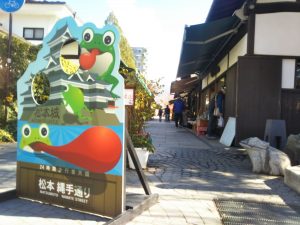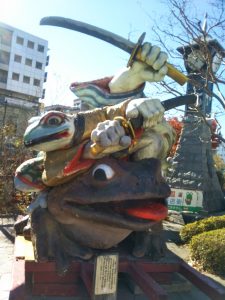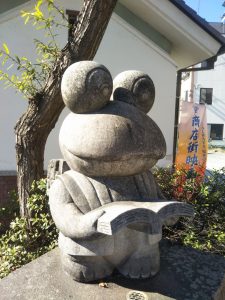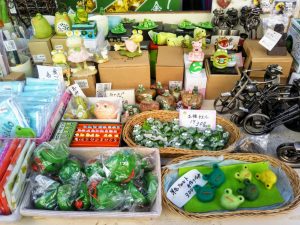“What’s With All the Frogs?”
The Story Behind Nawate Street
 Down along the northern banks of the Metoba River sits a quaint pedestrian lane called Nawate-dori. This name, a combination of the words for rope (nawa, 縄) and riverbank (dote, 土手), comes from the fact that this was once a narrow spit of land running between the river and the southern moat of nearby Matsumoto Castle.
Down along the northern banks of the Metoba River sits a quaint pedestrian lane called Nawate-dori. This name, a combination of the words for rope (nawa, 縄) and riverbank (dote, 土手), comes from the fact that this was once a narrow spit of land running between the river and the southern moat of nearby Matsumoto Castle.
With the appearance of Yohashira Shrine this rope of land became the de facto pathway for pilgrims. The shrine’s keepers, recognizing the opportunity in Nawate, began promoting various forms of entertainment to attract visitors. A string of entrepreneurial-minded locals followed suit by setting up businesses in stalls that lined both sides of the street. With the sound of flutes and drums floating out from the shrine grounds, the smell of acetylene torches in the air, the cries of the vendors, the laughter and the shrieking of children as they tried to catch goldfish from a metal tub, the boom and crackle of fireworks overhead and the chorus of Kajika frogs rising up from the Metoba River, Nawate had become a popular and lively place.

Then in Year 34 of the Showa Era (1959) disaster struck. A typhoon coupled with two straight days of rain turned the Metoba River into a bloated torrent, washing trees and debris up against its bridges, creating dams which caused the surrounding streets to flood. Every single structure along Nawate Dori was washed away, and only after a laborious cleanup of the land and a complete renovation of the riverbed walls did the area show signs of returning to its recent yet seemingly-distant past.
But the river had become dirty, and the locals’ beloved frogs were gone, having left in search of higher ground and cleaner water upstream. Without them, and their delightful nightly chorus, the spirit of Nawate was all but lost.
Yet Japan is the land of surviving traditions, and eventually the people decided to reclaim that Nawate spirit. Though the people could not bring the Kajika back they could keep them alive in memory – as the symbol and mascot of a rejuvenated Nawate-dori.
In Year 47 of the Showa Era (1972) the “Kaeru Daimyoujin” was created, a sort of playful ranine deity that would become central to the effort to bring back the clean Metoba River and the liveliness of Nawate Street. From this point forward this place would now be known as ‘Kaeru Machi’ (‘Frog Street’), a place where locals and travelers alike could come and enjoy the atmosphere of old Nawate.
 Interestingly, the Japanese word for ‘frog’ – kaeru – carries other phonetic meanings.
Interestingly, the Japanese word for ‘frog’ – kaeru – carries other phonetic meanings.
買える means ‘to be able to buy’ food, drink and goods from the vendors.
帰る means to return home (ostensibly safely).
可得る means to ‘be accepted’ by feeling welcome in this place.
And at least one shopkeeper working Nawate Street today will tell you about 若返る, or wakagaeru, a regained feeling of youth brought by the small ceramic frogs that, coincidentally, you can buy right there from him.
Though the chorus of frogs is long-gone, Nawate Dori, with its countless frogs and the feeling they elicit, remains a place where both locals and visitors can gather – to buy, to feel welcome, and, perhaps, to feel young again for a while before going back home.
